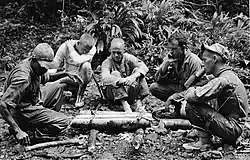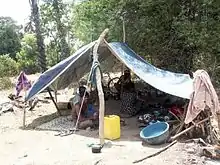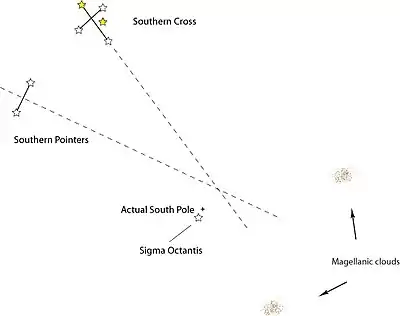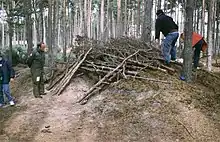Survival skills
Survival skills are techniques that a person may use in order to sustain life in any type of natural environment or built environment. These techniques are meant to provide basic necessities for human life which include water, food, and shelter. The skills also support proper knowledge and interactions with animals and plants to promote the sustaining of life over a period of time. Survival skills are often associated with the need to survive in a disaster situation.[1] Survival skills are often basic ideas and abilities that ancients invented and used themselves for thousands of years.[2] Outdoor activities such as hiking, backpacking, horseback riding, fishing, and hunting all require basic wilderness survival skills, especially in handling emergency situations. Bushcraft and primitive living are most often self-implemented but require many of the same skills.

First aid

First aid (wilderness first aid in particular) can help a person survive and function with injuries and illnesses that would otherwise kill or incapacitate him/her. Common and dangerous injuries include:
- Bites from snakes, spiders and other wild animals
- Bone fractures
- Burns
- Drowsiness
- Headache
- Heart attack
- Hemorrhage
- Hypothermia and hyperthermia
- Infection through food, animal contact, or drinking non-potable water
- Poisoning from consumption of, or contact with, poisonous plants or poisonous fungi
- Sprains, particularly of the ankle
- Vomiting
- Wounds, which may become infected
The survivor may need to apply the contents of a first aid kit or, if possessing the required knowledge, naturally occurring medicinal plants, immobilize injured limbs, or even transport incapacitated comrades.
Shelter

Many people who are forced into survival situations often have a risk of danger because of direct exposure to the elements. Most people in survival situations die of hypo/hyperthermia, or animal attacks. A shelter can range from a natural shelter, such as a cave, overhanging rock outcrop, or fallen-down tree, to an intermediate form of man-made shelter such as a debris hut, tree pit shelter, or snow cave, to completely man-made structures such as a tarp, tent, or longhouse. It is noted that some common properties between these structures are:
- Location (away from hazards, such as cliffs; and nearby materials, like food sources)
- Insulation (from ground, rain, wind, air, or sun)
- Heat Source (either body heat or fire-heated)
- Personal or Group Shelter (having multiple individuals)
Fire
Fire is a combustion reaction between oxygen and fuel that typically produces heat, light, and smoke. The resulting heat from the reaction can postpone or prevent the risk of hypothermia. Lighting a fire without a lighter or matches, e.g. by using natural flint and rock or metal with tinder, is a frequent subject of both books on survival and in survival courses, often due to the lack of said materials if an individual was stranded. There is an emphasis placed on practicing fire-making skills before venturing into the wilderness.[3] Producing fire under adverse conditions has been made much easier by the introduction of tools such as the solar spark lighter and the fire piston.
Fires are either started with a concentration of heat, as in the case of the solar spark lighter, or through a spark, as in the case of flint striking a rock or metal. Fires will often be put out if either there is excessive wind (such as either over fanning a fire, or strong winds), or if the fuel or environment is too wet to ignite.
Fire is presented as a tool meeting many survival needs. Along with the need that's mentioned above, it also disinfects water (through boiling and condensing), and can be used to cook and prevent illnesses in foods like animal meat. Another advantage that is presented through fire is an underlooked psychological boost through the sense of safety and protection it gives. In the wild, fire can provide a sensation of home, a focal point, in addition to being an essential energy source.[3] Fire may deter wild animals from interfering with an individual, however wild animals may be attracted to the light and heat of a fire.
Water

A human being can survive an average of three to five days without the intake of water. The issues presented by the need for water dictate that unnecessary water loss by perspiration be avoided in survival situations. The need for water increases with exercise.[4] Since the human body is composed of up to 89% water, it should be no surprise that water is higher on the list than fire or food. Ideally, a person should drink about a gallon of water per day. Many lost persons perish due to dehydration, and/or the debilitating effects of water-born pathogens from untreated water.
A typical person will lose minimally two to maximally four liters of water per day under ordinary conditions, and more in hot, dry, or cold weather. Four to six liters of water or other liquids are generally required each day in the wilderness to avoid dehydration and to keep the body functioning properly.[5] The U.S. Army survival manual does not recommend drinking water only when thirsty, as this leads to underhydrating. Instead, water should be drunk at regular intervals.[6][7] Other groups recommend rationing water through "water discipline".[8]
A lack of water causes dehydration, which may result in lethargy, headaches, dizziness, confusion, and eventually death. Even mild dehydration reduces endurance and impairs concentration, which is dangerous in a survival situation where clear thinking is essential. Dark yellow or brown urine is a diagnostic indicator of dehydration. To avoid dehydration, a high priority is typically assigned to locating a supply of drinking water and making provision to render that water as safe as possible.
Recent thinking is that boiling or commercial filters are significantly safer than use of chemicals, with the exception of chlorine dioxide.[9][10][11]
Food
Culinary root tubers, fruit, edible mushrooms, edible nuts, edible beans, edible cereals or edible leaves, edible moss, edible cacti and algae can be gathered and, if needed, prepared (mostly by boiling). With the exception of leaves, these foods are relatively high in calories, providing some energy to the body. Plants are some of the easiest food sources to find in the jungle, forest or desert because they are stationary and can thus be had without exerting much effort.[12] Skills and equipment (such as bows, snares, and nets) are necessary to gather animal food in the wild include animal trapping, hunting, and fishing.
Focusing on survival until rescued by presumed searchers, the Boy Scouts of America, or BSA, especially discourages foraging for wild foods on the grounds that the knowledge and skills needed are unlikely to be possessed by those finding themselves in a wilderness survival situation, making the risks (including use of energy) outweigh the benefits.[13]
Navigation

Those going for trips and hikes are advised[14] by Search and Rescue Services to notify a trusted contact of their planned return time, then notify them of your return. They can tell them to contact the police for search and rescue if you have not returned by a specific time frame (e.g. 12 hours of your scheduled return time).
Survival situations can often be resolved by finding a way to safety, or a more suitable location to wait for rescue. Types of navigation include:
- Celestial navigation, using the sun and the night sky to locate the cardinal directions and to maintain course of travel
- Using a map, compass or GPS receiver
- Dead reckoning
- Natural navigation, using the condition of surrounding natural objects (i.e. moss on a tree, snow on a hill, direction of running water, etc.)
Mind preparedness
The mind and its processes are critical to survival. The will to live in a life-and-death situation often separates those that live and those that do not. Situations can be stressful to the level that even trained experts may be mentally affected. One should be mentally and physically tough during a disaster.
To the extent that stress results from testing human limits, the benefits of learning to function under stress and determining those limits may outweigh the downside of stress.[15] There are certain strategies and mental tools that can help people cope better in a survival situation, including focusing on manageable tasks, having a Plan B available and recognizing denial.[16]
Urban survival
Earthquake
In a building collapse, it is advised that you:[17]
- Seek protection under a structure like a table
- Cover your mouth with your shirt to filter out dust
- Use your phone light to signal for help, or call
- Don't move until you are confident that something won't topple on you
Important survival items

Often survival practitioners will carry with them a "survival kit". This consists of various items that seem necessary or useful for potential survival situations, depending on anticipated challenges and location. Supplies in a survival kit vary greatly by anticipated needs. For wilderness survival, they often contain items like a knife, water container, fire-starting apparatus, first aid equipment, food obtaining devices (snare wire, fish hooks, firearms, or other,) a light, navigational aids, and signaling or communications devices. Often these items will have multiple possible uses as space and weight are often at a premium.
Survival kits may be purchased from various retailers or individual components may be bought and assembled into a kit.
Common questionable survival skills
Some survival books promote the "Universal Edibility Test".[18] Allegedly, it is possible to distinguish edible foods from toxic ones by a series of progressive exposures to skin and mouth prior to ingestion, with waiting periods and checks for symptoms. However, many experts including Ray Mears and John Kallas[19] reject this method, stating that even a small amount of some "potential foods" can cause physical discomfort, illness, or death.
Many mainstream survival experts have recommended the act of drinking urine in times of dehydration and malnutrition. However, the United States Air Force Survival Manual (AF 64-4) instructs that this technique is a myth and should never be applied. Several reasons for not drinking urine include the high salt content of urine, potential contaminants, and sometimes bacteria growth, despite urine's being generally "sterile".
Many classic cowboy movies, classic survival books, and even some school textbooks suggest that sucking the venom out of a snake bite by mouth is an appropriate treatment and/or also for the bitten person to drink their urine after the poisonous animal bite or poisonous insect bite as a mean for the body to provide natural anti-venom. However, the venom can not be sucked out and it may be dangerous for a rescuer to attempt to do so. Modern snakebite treatment involves pressure bandages and prompt medical treatment.[20]
See also
References
- "12 Outdoor Survival Skills Every Guy Should Master". Men's Fitness. 28 September 2017. Retrieved 28 September 2017.
- "Wilderness Survival Skills". www.wilderness-survival.co.uk. 28 September 2017. Retrieved 28 September 2017.
- Fears, J. Wayne (14 February 2011). The Pocket Outdoor Survival Guide: The Ultimate Guide for Short-Term Survival. Simon and Schuster. ISBN 978-1-62636-680-0.
- HowStuffWorks by Charles W. Bryant
- Water Balance; a Key to Cold Weather Survival by Bruce Zawalsky, Chief Instructor, BWI
- "Army Survival Manual; Chapter 13 – Page 2". Aircav.com. Retrieved 21 October 2011.
- "U.S. Army Survival Manual FM 21-76, also known as FM 3-05.70 May 2002 Issue; drinking water". Survivalebooks.com. Retrieved 21 October 2011.
- "Water Discipline" at Survival Topics
- "US EPA". Archived from the original on 29 December 2011. Retrieved 27 December 2011.
- "Survival Water Filter". Retrieved 26 October 2020.
- "Wisconsin Dept. of Natural Resources". Dnr.wi.gov. 11 March 2008. Archived from the original on 8 March 2012. Retrieved 21 October 2011.
- "Master The Great Outdoors". SurvivalGrounds.com. Retrieved 21 October 2011.
- Wilderness Survival Merit Badge pamphlet, January 2008, at 38
- Police, Victoria. "Victoria Police - Search and Rescue Squad". www.police.vic.gov.au.
- Krieger, Leif (3 April 2011). "How to Survive Any Situation". How to Survive Any Situation. Silvercrown Mountain Outdoor School.
- Leach, John (1994). Survival Psychology. NYU Press.
- https://www.ready.gov/earthquakes
- US Army Survival Manual FM21-76 1998 Dorset press 9th printing ISBN 1-56619-022-3
- John Kallas, PhD, Director, Institute for the Study of Edible Wild Plants and Other Foragables. Biography Archived 13 February 2014 at the Wayback Machine
- Lawson, Malcolm (2013). "Top 10 Survival Myths Busted". SCS. DNM International. p. 1. Archived from the original on 27 April 2015. Retrieved 18 April 2015.
Further reading
- Mountaineering: The Freedom of the Hills; 8th Ed; Mountaineers Books; 596 pages; 1960 to 2010; ISBN 978-1594851384.
External links
| Wikimedia Commons has media related to Survival skills. |
- Media
- The short film Aircrew Survival: Cold Land Survival is available for free download at the Internet Archive
- The short film Aircrew Survival: Hot Land Survival is available for free download at the Internet Archive
- The short film Aircrew Survival: Survival Kits, Rafts, Accessories is available for free download at the Internet Archive
- The short film Aircrew Survival: Survival Medicine is available for free download at the Internet Archive
- The short film Aircrew Survival: Surviving on Open Water is available for free download at the Internet Archive
- The short film Aircrew Survival: Survival Signalling is available for free download at the Internet Archive
- The short film Aircrew Survival: Tropical Survival is available for free download at the Internet Archive
- The short film Aircrew Survival: The Will to Survive is available for free download at the Internet Archive
